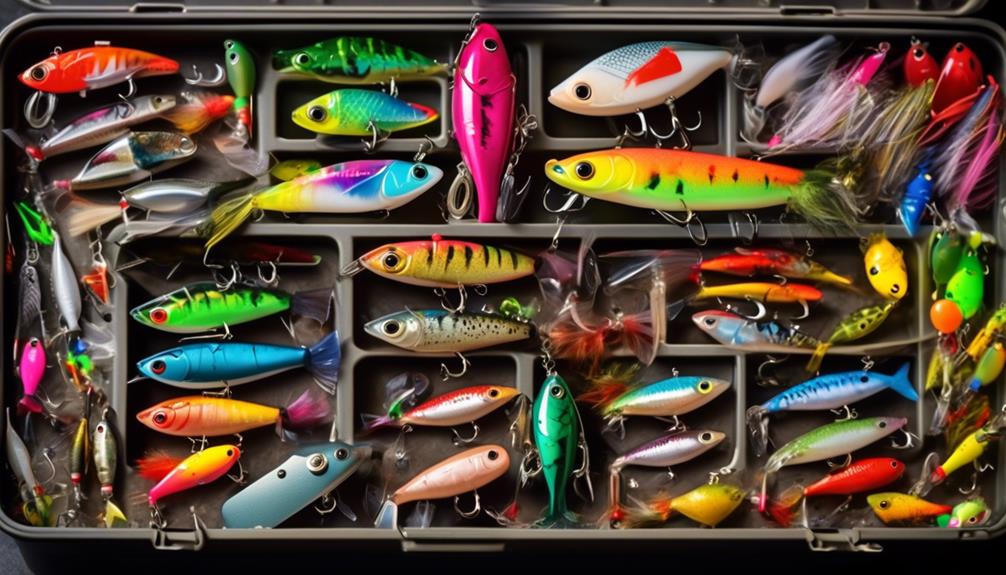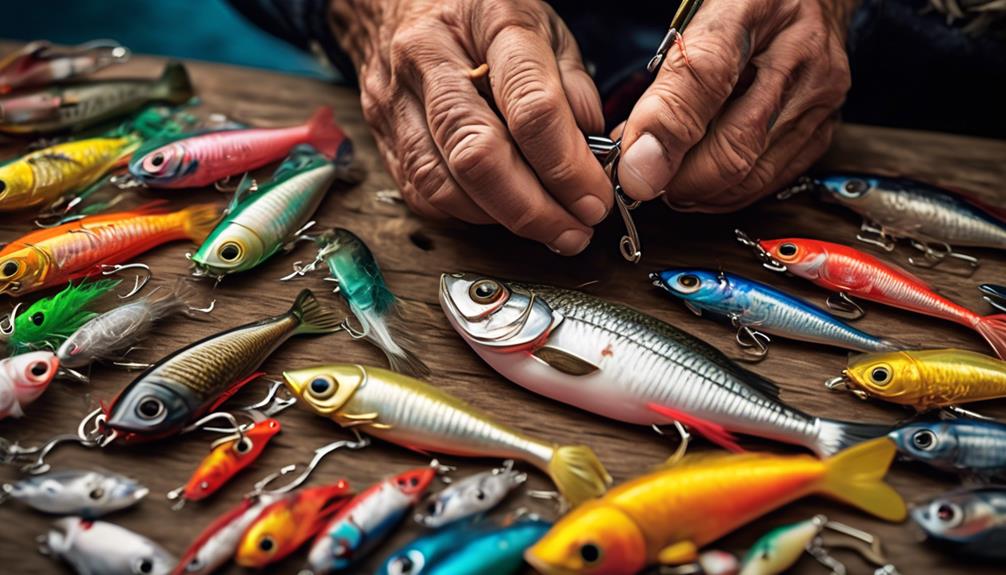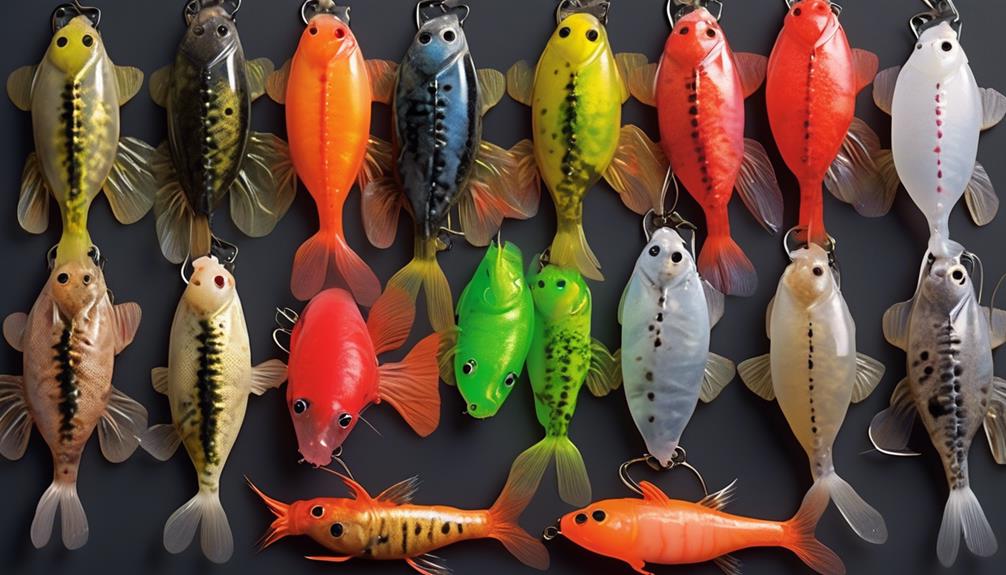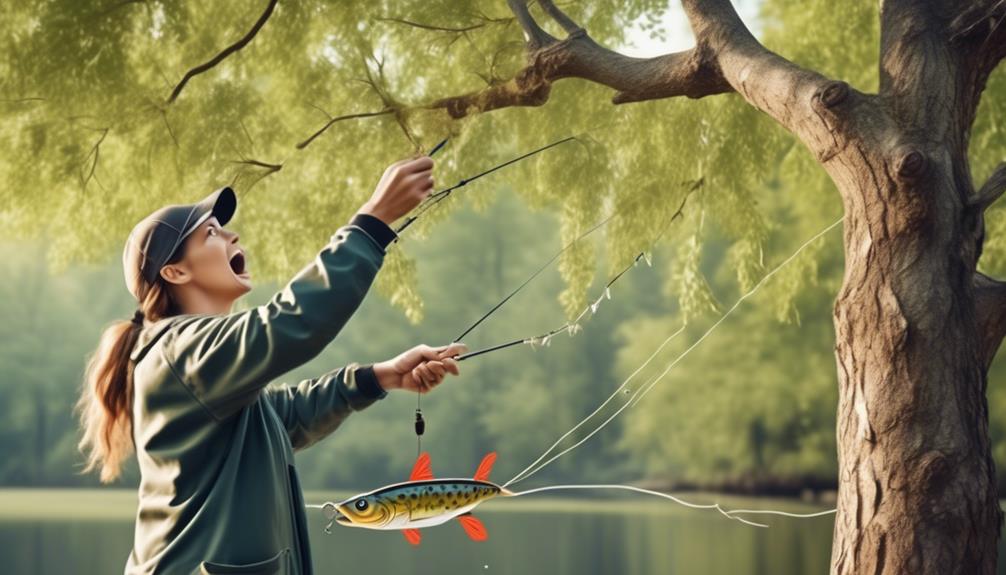As a new angler, you may find yourself overwhelmed by the sheer variety of baits and lures available to you. The choice between live bait and artificial lures can be a daunting one, but fear not, as we are here to guide you through the process of selecting the best options for your fishing endeavors.
By understanding the benefits of using artificial lures and the top live bait options for beginners, you can start to hone in on the most effective strategies for landing your first big catch.
But before you rush out to buy your equipment, there are a few key factors to consider when selecting the right baits and lures for your next fishing trip.
Benefits of Using Artificial Lures
When fishing, artificial lures can significantly increase your chances of catching fish due to their lifelike appearance and enticing movement. The design of artificial lures is crafted to mimic the look and behavior of natural prey, which can attract various fish species. This lifelike representation is one of the key benefits of using artificial lures.
Unlike live bait, artificial lures don't require constant maintenance or refrigeration, making them more convenient and easier to carry during your fishing trips. Additionally, their durability ensures that they can withstand multiple bites and remain effective throughout your angling adventure.
Another advantage of using artificial lures is their versatility in design. These lures come in a wide range of shapes, sizes, and colors, allowing you to choose the perfect lure for different fishing conditions and target species. Whether you're fishing in clear waters or murky depths, there's a specific artificial lure designed to optimize your chances of success. Their ability to be customized and adapted to specific fishing scenarios is a significant advantage over traditional live bait.
Artificial lures also offer the benefit of being reusable. Unlike live bait, which can only be used once, artificial lures can be cast multiple times without losing their effectiveness. This reusability not only saves you money in the long run but also reduces the environmental impact of discarded live bait.
Top Live Bait Options for Beginners
For new anglers, selecting the right live bait can be crucial to attracting and catching fish successfully. When it comes to live bait options, worms and minnows are two of the most effective choices for beginners.
Worms are readily available, easy to handle, and attract a wide variety of fish species. They can be used in various environments, from freshwater lakes to slow-moving rivers.
Minnows, on the other hand, are ideal for attracting larger predatory fish and are particularly effective in moving waters.
Nightcrawlers are another top live bait option for beginners. They're larger worms that are highly appealing to fish and can be used to target a wide range of species, including bass, trout, and walleye. Nightcrawlers are durable and can withstand multiple strikes, making them a reliable choice for novice anglers.
Additionally, crickets are excellent live bait for beginners, especially when targeting panfish and trout. They're easy to handle and can be used in both still and moving waters, making them versatile for various fishing environments.
When using live bait, it's important to handle them with care to ensure they remain lively and attractive to fish. Keep them in a cool and moist environment to maintain their freshness and effectiveness.
Understanding Soft Plastic Baits
Soft plastic baits are versatile and effective lures that can be used to attract a wide variety of fish species. When it comes to choosing soft plastic bait colors, it's essential to consider the water clarity and the natural prey of the fish you're targeting. In clear water, natural colors like green pumpkin, watermelon, and shad patterns can be very effective. In stained or murky water, it's often better to go for brighter or darker colors that can be more easily seen by the fish, such as chartreuse, black, or blue.
Rigging soft plastic baits properly is crucial for their effectiveness. One popular rigging method is the Texas rig, where the hook is embedded into the plastic bait to make it weedless and then paired with a bullet-shaped weight. This setup is great for fishing around vegetation or structure.
Another popular rigging method is the Carolina rig, which involves a bullet weight on the mainline and a leader with the soft plastic bait and hook. This allows the bait to move more freely and is excellent for covering a lot of water.
Remember that the key to success with soft plastic baits is experimentation. Fish can be picky, so don't be afraid to try different colors and rigging techniques until you find what works best for the specific conditions and fish species you're targeting.
Must-Have Spinnerbaits for New Anglers
After mastering the rigging techniques and color considerations for soft plastic baits, new anglers should now turn their attention to acquiring must-have spinnerbaits for their tackle box. Spinnerbaits are versatile lures that can be incredibly effective in a variety of fishing situations.
When it comes to spinnerbait techniques, casting plays a crucial role. It's important to practice casting spinnerbaits near cover and structure to entice strikes from lurking fish. As you become more comfortable with casting spinnerbaits, you can experiment with different retrieval speeds and depths to determine what works best in various conditions.
Spinnerbait customization and color selection are also important aspects to consider. Many spinnerbaits allow for customization by adding or changing the skirts, blades, or trailers. This can help you tailor the lure to match the local forage and environmental conditions.
As for color selection, it's generally advisable to have a few different options on hand to adapt to changing light and water conditions. Brighter colors can be effective in murky water or low light, while natural or more subdued colors may work better in clear water or bright sunlight.
As you begin to build your collection of spinnerbaits, consider selecting a range of sizes and blade configurations to cover various fishing scenarios. By incorporating these spinnerbait techniques, casting tips, and customization strategies into your angling repertoire, you'll be well-equipped to tackle a wide array of fishing environments and conditions.
Effective Jigging Techniques for Beginners
One essential technique for beginners is mastering effective jigging methods to entice strikes from fish in varying water depths and conditions. Basic jigging involves raising and lowering the lure in a way that mimics the movement of prey, making it an enticing target for fish. To start, it's important to avoid beginner mistakes such as jigging too aggressively or too erratically, which can deter fish instead of attracting them. Instead, focus on a smooth and controlled jigging motion, keeping the lure moving in a natural and lifelike manner.
When practicing basic jigging, remember to start with small movements and gradually increase the intensity to find the most effective technique for the specific fishing conditions. Keep in mind that different fish species may respond to different jigging styles, so it's essential to experiment and observe how fish react to the lure's movements. Additionally, paying attention to the feedback from the line can provide valuable insights into the effectiveness of the jigging technique.
To maximize success, vary the speed and depth of your jigging to entice fish in different parts of the water column. By mastering these basic jigging techniques and avoiding common beginner mistakes, you can significantly increase your chances of enticing strikes from a wide range of fish species.
Choosing the Right Crankbaits for Novices
When selecting the right crankbaits as a novice angler, it's crucial to consider the specific characteristics and features that will appeal to the fish you're targeting.
Crankbait colors play a significant role in attracting fish. For beginners, it's advisable to start with natural colors such as shad, perch, or crawfish imitations, as these are versatile and tend to work well in various water conditions.
Additionally, it's important to understand the retrieval techniques for crankbaits. As a novice angler, mastering the art of varying retrieval speeds and incorporating pauses to mimic injured baitfish can significantly increase your success with crankbaits.
Understanding the depth at which crankbaits run is essential. Different crankbaits are designed to dive to specific depths, and this aspect is crucial in effectively targeting fish.
For beginners, it's recommended to begin with medium-diving crankbaits as they're versatile and can be used in a wide range of water depths.
Moreover, being aware of the water conditions is vital when choosing the right crankbaits.
Murky or stained water may require brighter or louder crankbaits to enhance visibility and attract fish, while clear water conditions may necessitate more natural and subtle presentations.
Tips for Using Topwater Lures
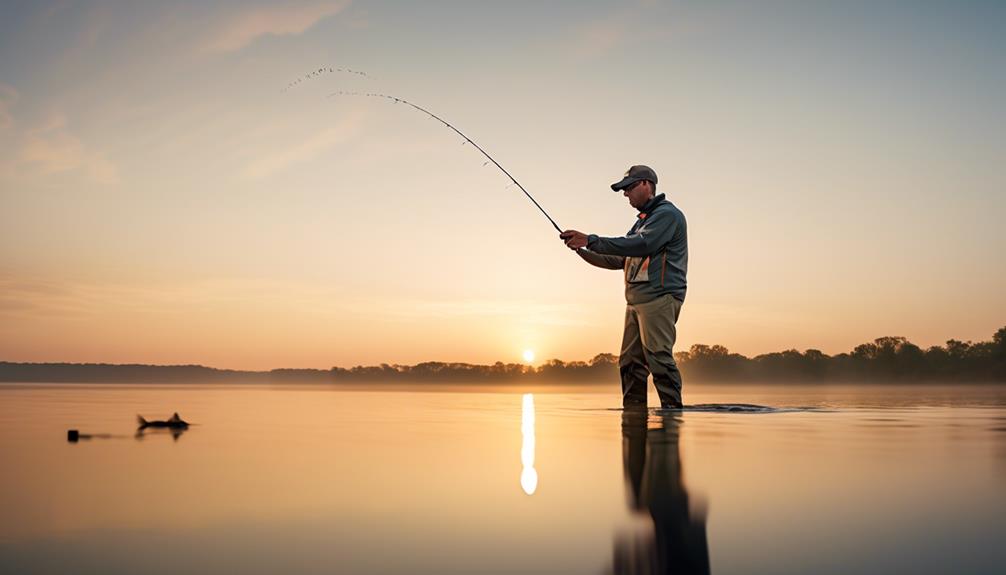
To further expand your angling skills, mastering the techniques for using topwater lures can complement your understanding of crankbait selection and retrieval. When it comes to night fishing techniques, topwater lures can be incredibly effective. The low light conditions make it harder for fish to detect your movements, so using topwater lures with a noisy or splashy action can attract them. Try using lures with rattles or poppers that create commotion on the water's surface, increasing your chances of a successful catch.
Casting accuracy is paramount when using topwater lures. To improve your accuracy, focus on your casting technique. Make sure to release the lure at the right moment during your forward motion to achieve the desired distance and placement. Additionally, practicing your casting in different conditions, such as windy or calm weather, can help you become more versatile and adaptable to various fishing environments.
Another tip for using topwater lures is to pay attention to the speed of your retrieval. Varying your retrieval speed can make your lure mimic the movement of prey, making it more enticing for the fish. Experiment with different speeds until you find the one that garners the most bites.
Incorporating these tips into your angling repertoire can enhance your overall fishing experience and increase your chances of reeling in a great catch.
Selecting the Best Terminal Tackle
Selecting the best terminal tackle is crucial for optimizing your fishing setup and increasing your chances of a successful catch. When it comes to proper hook sizes, it's important to match the hook to the size of the fish you're targeting. For smaller fish like panfish, a size 6 or 8 hook would be suitable, while larger game fish might require a size 2 or 4 hook. Using the right hook size ensures that the fish can properly take the bait without feeling too much resistance, improving your chances of a solid hookset.
Weight and bobber selection are also essential components of terminal tackle. The weight of your rig is determined by the depth and current of the water. For deeper or faster-moving water, a heavier weight is needed to keep your bait at the desired depth. Conversely, lighter weights are suitable for shallow or slower waters.
When using live bait or fishing near the surface, a bobber can be helpful in suspending the bait at the right depth and indicating when a fish is biting. It's essential to choose the appropriate size and type of bobber based on the conditions of the water you're fishing in.
Frequently Asked Questions
How Can New Anglers Determine the Best Time of Day to Use Different Types of Baits and Lures?
To determine the best time of day to use different baits and lures, consider ideal weather and water temperature.
During early morning or late afternoon, when the weather is cooler, fish tend to be more active.
In warmer weather, it's best to fish during early morning or late evening.
As the water warms up, fish tend to move deeper, so using lures that can reach them at deeper depths will be more effective.
Are There Any Specific Techniques for Using Soft Plastic Baits in Different Water Conditions?
When using soft plastic baits in different water conditions, it's crucial to adjust your presentation tactics accordingly.
In murky waters, opt for brighter colors and slower retrieval to ensure visibility.
For clear waters, natural colors and faster retrieval can be more effective.
Experiment with different casting techniques to find what works best for the specific conditions.
Adapting your approach to the water conditions will increase your chances of success with soft plastic baits.
What Are Some Common Mistakes New Anglers Make When Using Spinnerbaits, and How Can They Avoid Them?
When using spinnerbaits, new anglers commonly make mistakes like retrieving too fast or too slow, not varying the retrieval speed, and using the wrong size or color.
To avoid these, pay attention to the water conditions, adjust the retrieval speed, and experiment with different spinnerbait sizes and colors.
Also, make sure to maintain a steady retrieve and keep the spinnerbait at the right depth.
These tips will help you improve your spinnerbait fishing skills.
Can You Provide Some Tips for Effectively Using Jigging Techniques in Deep Water?
When jigging techniques in deep water, focus on using heavier jigs to reach the bottom and maintain contact. Vary your retrieve speed and experiment with different jigging motions to entice bites.
In shallow water, crankbait techniques can be effective for covering a lot of water and triggering strikes from active fish. Keep your rod tip down and maintain a steady retrieve to get the most out of your crankbait in shallow areas.
Are There Any Special Considerations for Using Topwater Lures in Different Seasons or Weather Conditions?
When using topwater lure techniques, it's crucial to consider seasonal tips and weather conditions.
In different seasons, fish exhibit varying behaviors, so adjust your approach accordingly. Pay attention to weather patterns like wind and cloud cover, as they can affect fish response to topwater lures.
During warmer months, early mornings and evenings are prime times for topwater action.
In colder weather, focus on sunny days when fish are more active near the surface.
Conclusion
So, why choose these baits and lures for new anglers?
Using artificial lures can be more convenient and less messy than live bait, while still being effective.
Top live bait options, soft plastic baits, spinnerbaits, jigging techniques, crankbaits, and topwater lures all offer different advantages for beginners.
By selecting the best terminal tackle, new anglers can improve their chances of success and enjoy a more rewarding fishing experience.
Happy fishing!
